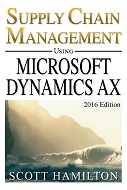Fundamentals of Defining a Material Item Using Microsoft Dynamics AX
Editor's Note: This represents the first of a 3-part article, and is drawn from Dr. Hamilton's recently published books about supply chain management (SCM) in manufacturing and distribution businesses. The books cover the software capabilities within AX 2012 R3 as well as the new Dynamics AX. One book focuses on SCM for Discrete Manufacturing and a second focuses on SCM for Process Manufacturing. The third book applies to both, and covers the major options for Warehouse Management.
Information about material items provides the foundation for managing supply chain activities in distribution and manufacturing businesses. However, prior to implementing an integrated system, it is not uncommon to have many different systems with separate definitions of a material item to support requirements of different groups. These differing viewpoints include sales, purchasing, warehouse management, quality and accounting, as well as engineering and production for manufactured items. Other relevant viewpoints include customers, vendors, intercompany coordination, international operations, industry standards and web-based applications.
This 3-part article reviews some of the fundamentals of defining a material item within AX, and how to support the differing viewpoints. The first article reviews a typical business process to define a material item, where the typical process requires an understanding of enterprise- versus company-level information about an item. These topics are reflected in the following sections within the article.
- Enterprise- versus Company-Level Information for an Item
- Typical Business Process to ...
FREE Membership Required to View Full Content:
Joining MSDynamicsWorld.com gives you free, unlimited access to news, analysis, white papers, case studies, product brochures, and more. You can also receive periodic email newsletters with the latest relevant articles and content updates.
Learn more about us hereor login





